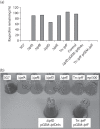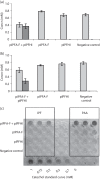Genetic and chemical characterization of ibuprofen degradation by Sphingomonas Ibu-2
- PMID: 23329679
- PMCID: PMC4083657
- DOI: 10.1099/mic.0.062273-0
Genetic and chemical characterization of ibuprofen degradation by Sphingomonas Ibu-2
Abstract
Sphingomonas Ibu-2 has the unusual ability to cleave the acid side chain from the pharmaceutical ibuprofen and related arylacetic acid derivatives to yield corresponding catechols under aerobic conditions via a previously uncharacterized mechanism. Screening a chromosomal library of Ibu-2 DNA in Escherichia coli EPI300 allowed us to identify one fosmid clone (pFOS3G7) that conferred the ability to metabolize ibuprofen to isobutylcatechol. Characterization of pFOS3G7 loss-of-function transposon mutants permitted identification of five ORFs, ipfABDEF, whose predicted amino acid sequences bore similarity to the large and small units of an aromatic dioxygenase (ipfAB), a sterol carrier protein X (SCPx) thiolase (ipfD), a domain of unknown function 35 (DUF35) protein (ipfE) and an aromatic CoA ligase (ipfF). Two additional ORFs, ipfH and ipfI, which encode putative ferredoxin reductase and ferredoxin components of an aromatic dioxygenase system, respectively, were also identified on pFOS3G7. Complementation of a markerless loss-of-function ipfD deletion mutant restored catechol production as did complementation of the ipfF Tn mutant. Expression of subcloned ipfABDEF alone in E. coli did not impart full metabolic activity unless coexpressed with ipfHI. CoA ligation followed by ring oxidation is common to phenylacetic acid pathways. However, the need for a putative SCPx thiolase (IpfD) and DUF35 protein (IpfE) in aerobic arylacetic acid degradation is unprecedented. This work provides preliminary insights into the mechanism behind this novel arylacetic acid-deacylating, catechol-generating activity.
Figures





References
-
- Altschul S. F., Gish W., Miller W., Myers E. W., Lipman D. J. (1990). Basic local alignment search tool. J Mol Biol 215, 403–410. - PubMed
-
- Aziz R., Saad R., Rizkallah M. (2011). PharmacoMicrobiomics or how bugs modulate drugs: an educational initiative to explore the effects of human microbiome on drugs. BMC Bioinformatics 12 (Suppl. 7), A10 10.1186/1471-2105-12-S7-A10 - DOI
-
- Black P. N., DiRusso C. C., Metzger A. K., Heimert T. L. (1992). Cloning, sequencing, and expression of the fadD gene of Escherichia coli encoding acyl coenzyme A synthetase. J Biol Chem 267, 25513–25520. - PubMed
Publication types
MeSH terms
Substances
Associated data
- Actions
Grants and funding
LinkOut - more resources
Full Text Sources
Other Literature Sources

